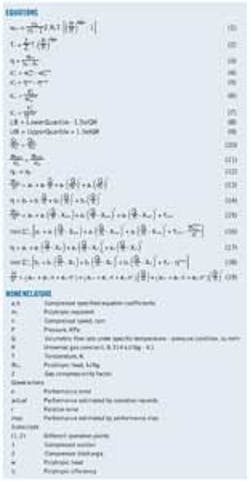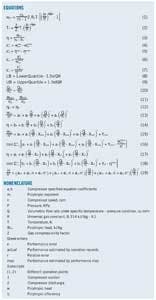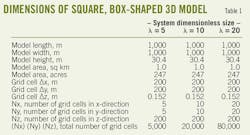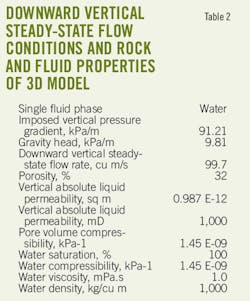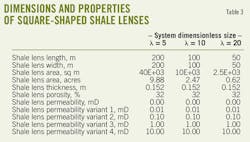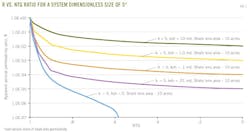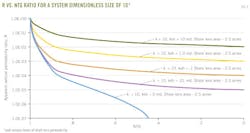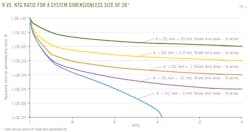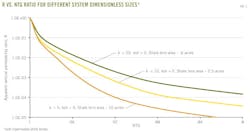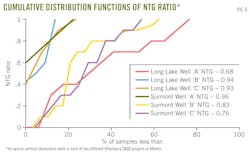Shale lenses limit commercial application of SAGD process
J.K. Dietrich
The Dietrich Corp.
Palm Springs, Calif.
The earliest steam assisted gravity drainage (SAGD) pilot projects have been installed and operated in the Athabasca and Cold Lake oil sands of Alberta, Canada, and many of these pilots are now mature.
Unfortunately, target oil production rates and thermal efficiencies have been met in only two of the 10 or more, pilots.1 2 Although problems related to steam shortages, high hydrogen sulfide concentrations and fluid saturations were responsible for poor performance in some projects, the key feature of the unsuccessful pilots was the assumption of reservoir homogeneity and a lack of awareness concerning the impedance effects caused by the presence of discontinuous shale lenses.
As a means of understanding the singular effects of shale, a term called the apparent vertical permeability ratio (R) has been correlated to NTG ratio for systems containing square, box-shaped shale lenses that are either impermeable or permeable and randomly distributed as 3D arrays. In these types of systems, shale lenses occupying only 5% of the bulk volume are shown to be capable of reducing the vertical permeability of a homogeneous and isotropic reservoir by two to three orders of magnitude, or more.
Differences in the NTG ratios and correlated R values calculated at various field sites may be helpful for understanding observed significant differences in horizontal well productivity and SAGD project performance.
Results presented here reveal that with respect to Athabasca and Cold Lake, it is only the bitumen and heavy oil occurring within the homogeneous, multiple stacked channel sands that are likely to be exploited commercially with an SAGD process. The demonstrated intolerance of SAGD to the presence of shale lenses was forewarned by the founder of the process when he wrote: "A significant concern in the development of the SAGD process is that of the possible effects of barriers to vertical flow within the reservoir."3
Introduction
In one of the first field applications of SAGD, it was recognized that sluggish oil response in the Kern River horizontal well steam pilot conducted from 1979 to 1982 was caused by placement of the production laterals beneath a low permeability shale lens.4
Nearly 20 years later, an article appeared in the petroleum literature entitled "On the difficult birth of SAGD."5 It was supposed in that article that installed facilities and lifting capacities are often underdesigned and therefore responsible for poorer than anticipated SAGD performance.
Although that supposition may be correct, it does not consider that natural potential may be part of the problem, because, as stated, "…unrealistically low values for kv/kh…" would need to be encountered at the field sites to raise concern about natural potential. By natural potential we mean the rate at which injected steam can rise and heated bitumen can drain downwards from a developing steam chest to the horizontal laterals.
What are unrealistically low values for kv/kh and how may this ratio be estimated? This question has been addressed by several authors using analytical methods, first by Dupuy and Lefevre du Prey6 and later by Prats7 and Chirlin.8 The later authors described the effect of discontinuous shales on apparent permeability anisotropy using three parameters: α for the degree of shale overlap, W for the width of a shale, and H for the vertical distance separating two shales.
For the case of partially overlapping shales and large values for the W/H ratio, it was found that the vertical permeability vanishes as the W/H ratio increases. In other words, under some practical conditions relating to shale occurrence, it has been demonstrated that there are no unrealistically low values for kv/kh. The analytical methods assume that the shale lenses are impermeable infinite strips of zero thickness, distributed as 2D oriented arrays in a repetitive pattern.
Numerical results are presented here to extend the early analytical work by demonstrating the effects of square box-shaped shale lenses that are either impermeable or permeable and randomly distributed as 3D arrays. An apparent vertical permeability ratio is defined here as Equation 1 where kv° is the vertical permeability in a reservoir containing shale lenses and kv is the vertical permeability in a reservoir devoid of shale lenses.
Using procedures described later, we have computed values for R as functions of NTG ratio and plotted them for several values of shale lens permeability and areal size. The motivation for this undertaking has been to develop a predictor of horizontal well productivity that is affected by differences in shale content.
Analytical expressions presently used to estimate horizontal well productivity include those offered by Butler.3 His Lindrain equation (Equation 2) was formulated to approximate the oil rate measured in physical model experiments of the SAGD process that were unaffected by shale content.
This development notwithstanding, the Lindrain equation continues to serve as an analytical expression for predicting SAGD performance at the field scale. Butler3 also introduced an analytical expression for calculating pseudo steady-state liquid flow to a horizontal well, which includes a dimensionless pressure term (Ps*) to approximate the pressure needed to cause vertical flow convergence (Equations 3 and 4).
The permeability terms in Equations 2, 3, and 4 are generally sourced from laboratory measurements of highly permeable core material. It may be possible to improve the application of these equations at the field scale by including an R term in them to account for the effects of shale lenses on apparent permeability anisotropy (Equations 5 and 6).
Procedures
It is known that R is related to sand body connectivity, which percolation theory9 demonstrates is a function of NTG ratio and system dimensionless size, λ (Equation 7).
Given this awareness, procedures were followed to compute R = f (NTG, λ, ksh) where ksh is the permeability of the shale lenses. R was computed by dividing the downward, vertical, steady-state flow rate of an incompressible liquid in a system containing stochastically distributed shale lenses (qv°) by the flow rate achievable in the same system devoid of shale lenses (qv) (Equations 8, 9, and 10).
A 3D reservoir model was used in which several variants of the areal grid system were generated to handle the stochastic distribution of shale (Table 1). Although the overall dimensions of each model were the same, the areal grid of each model was changed to define different values for the system dimensionless size. λ values of 5, 10, and 20 were used to allow modeling the effects of several different sizes of shale lenses, covering areas of ~10, 21⁄2, and 6⁄10-acre, respectively. In all cases, the thickness of each shale lens was set to 0.152 m, a value that corresponds to the minimum well-log sampling interval normally available. The models without shale lenses contained homogeneous and isotropic reservoir properties.
Water was injected into the top layer and withdrawn from the bottom layer of all models in response to uniformly imposed constant-pressure boundary conditions (Table 2). Upon reaching steady-state flow conditions, the numerical solution for the throughput rate in each homogeneous and isotropic model was validated by comparing it to the analytical solution given by Equation 9.
A computer program10 was used to populate the reservoir models with NTG arrays by randomly sampling cumulative distribution functions (CDFs)11 of NTG ratio. The shale lenses were initially represented by grid cells containing sampled values of NTG = 0.
It was necessary to modify the transmissibility coefficients (Tx, Ty, Tz) internally computed by the simulator to properly model the impedance effects of different shale lens permeability values of 0.01, 0.1, 1.0, and 10 md (Table 3). For example, it was necessary to reset NTG for grid cells representing shale and initially populated with values of NTG = 0 as in Equation 11 in order to compute the correct values for Tx and Ty.
Results
Computed values of R are plotted in Fig. 1 vs. NTG ratio for a system dimensionless size of 5 and several values of shale lens permeability.
The dimensionless size of 5 is equal to the square root of the model area open to downward vertical flow (insert square root expression) divided by the square root of the area of a square-shaped shale lens (√–). The same type of plots are shown as Figs. 2 and 3 for system dimensionless sizes of 10 and 20, where the R values represent the effects of tortuous, downward vertical flow through a reservoir containing randomly distributed, square-shaped shale lenses, each covering areas of (100 m)2 and (50 m)2, respectively.
R is shown to be capable of vanishing as NTG approaches intermediate values for the condition of impermeable shale lenses. In these systems, sand body connectivity is lost below a limiting value of NTG, which is a function of the system dimensionless size and called the apparent percolation threshold.9 Fig. 4 shows that sand body connectivity is lost at higher NTG ratios for bigger shale lenses.
When these numerical results are extrapolated to an infinite system dimensionless size as shown in Fig. 4, a percolation threshold of 0.31 is reached which is in exact agreement with the threshold published for site percolation in a randomly populated, infinite simple cubic lattice.9 For finite values of shale lens permeability, apparent percolation thresholds are absent and R asymptotically approaches the ratio of ksh/kv as NTG approaches zero.
Discussion
The term shale as used here is a proxy for various low permeability rock types, including those of the McMurray formation at Athabasca in Alberta, where most of the SAGD pilot projects have been installed to date.
Unit B of the McMurray formation consists of conglomeratic to fine-grained, oil-rich sandstones, frequently coal bearing with thinly interbedded sandstones, silty mudstones, and clay breccias.12 Shale lenses occupying only 5% of the bulk volume of a reservoir are shown here to be capable of reducing the vertical permeability of a homogeneous and isotropic system by two to three orders of magnitude or more (Fig. 5).
These results suggest that the SAGD production rate predicted by the Lindrain equation may be overstated by the factor (insert square root expression) when the effects of these flow impediments are ignored. Although at first surprising, these numerically demonstrated levels of permeability reduction should not be unexpected in view of analytical results published decades ago for two dimensional systems.8
The NTG ratio for Unit B of the McMurray formation has been calculated at locations penetrated by several observation wells in two different SAGD projects at Athabasca (Fig. 6). The CDFs of NTG ratio were prepared by blocking interpreted ASCII log data at 1.5-m intervals using cutoffs of Φ ≥0.28, Sw ≤0.35, and Vsh ≤0.40 to define the net permeable rock.
The area under each CDF curve represents the overall NTG ratio for Unit B at each observation well. The higher NTG ratios of 0.93 to 0.96 result from the presence of several thin, highly cemented sandstone lenses that are effectively impermeable, whereas the lower NTG ratios of 0.68 to 0.83 result from the presence of greater amounts of mudstones and clay breccias that are likely to have permeability values in the range of 0.01 to 10 md.
By far the most important result demonstrated here is the rapid decrease of the R value as shale is added to the system, regardless of the level of shale permeability or the system dimensionless size. As reported recently by Le Ravalec et al.,13 it is the first percents of shale that have the strongest impact on the natural potential of SAGD.
The results suggest that differences in the NTG ratios and R values calculated at various observation well locations may be useful for understanding differences in performance observed among different well pairs or pads or for recognizing well pair locations that should not be developed using SAGD technology. In sites that are alike except in their shale content, a change in the R value by an order of magnitude is shown to be capable of changing the calculated horizontal well production rates by a factor of ~√–.
We recognize that the results are based on a simple model that may limit their relevance. For example, although percolation theory indicates that reservoir connectivity will be a function of the aspect ratio or shape of the shale lenses, only square lenses have been considered here. Evaluation of rectangular shale lens geometry is not expected to lead to significantly different results, although this needs to be demonstrated, along with further evaluation of the effects of system dimensionless size.
The results demonstrate the flow resistance of shale lenses to incompressible, single-phase flow. Although there is purportedly less of an effect under two-phase flow conditions,14 it is the effect of differences in absolute liquid permeability on relative well performance that is considered here.
Finally, in those locations where good quality, multiple stacked channel sands are not present and the initial cold oil mobility is negligible, an alternative to the SAGD process involving high rate steam injection through horizontally induced artificial fractures may merit pilot testing.15-17 Dusseault18 offers that induced hydraulic fractures should adopt a horizontal attitude at all depths down to at least 330 m at Athabasca and down to ~450 m at Cold Lake.
Conclusions
1. A term called the apparent vertical permeability ratio (R) has been correlated to NTG ratio for systems containing square, box-shaped shale lenses that are either impermeable or permeable and randomly distributed as 3D arrays.
2. In these types of systems, shale lenses occupying only 5% of the bulk volume are shown to be capable of reducing the vertical permeability of a homogeneous and isotropic reservoir by two to three orders of magnitude, or more.
3. R is shown to be capable of vanishing as NTG approaches intermediate values for the condition of impermeable shale lenses. In these systems, sand body connectivity is lost below a limiting value of NTG, which is a function of the system dimensionless size and called the apparent percolation threshold.
4. For finite values of shale lens permeability, apparent percolation thresholds are absent and R asymptotically approaches the ratio of ksh/kv as NTG approaches zero.
5. Differences in the calculated NTG ratios and correlated R values at different field sites may be helpful for understanding observed differences in horizontal well productivity and predicting response before drilling SAGD horizontal wells.
References
1. Bryson, C., and MacKenzie, S., "JOGMEC SAGD performance study final presentation," RPS Energy Canada, PowerPoint presentation, Tokyo, Sept. 29, 2009 (http://trc.jogmec.go.jp/pdf).
2. Jimenez, J., "The field performance of SAGD projects in Canada," SPE 12860, presented at the International Petroleum Technology Conference, Kuala Lumpur, Dec. 3-5, 2008 (doi: 10.2523/12860-MS).
3. Butler, R.M., "Horizontal wells for the recovery of oil, gas and bitumen," Petroleum Society of CIM, Monograph Series, Vol. 2, 1994, pp. 172-76.
4. Dietrich, J.K., "The Kern River horizontal well steam pilot," SPE Res. Eng. 3, Vol. 3, 1988, pp. 935-44, SPE-16346-PA (doi: 10.2118/16346-PA).
5. Edmunds, N., "On the difficult birth of SAGD," J. Cdn. Pet. Tech. 38, Vol. 1, 1999 (doi: 10.2118/99-01-DA).
6. Dupuy, M., and Lefevre du Prey, E., "L'Anisotropie d'ecoulement en milieux poreux presentant des intercalations horizontales discontinues association des recherche sur les techniques de forage et de production,'' Colloque Troisieme Editions Technip, Paris, 1965, pp. 643-76.
7. Prats, M., "The influence of oriented arrays of thin impermeable shale lenses or of highly conductive natural fractures on apparent permeability anisotropy," JPT 24, Vol. 10, 1972, pp. 1,219-21 (SPE-4163-PA, doi: 10.2118/4163-PA).
8. Chirlin, G.R., "Flow through a porous medium with periodic barriers or fractures," SPE J. 25, Vol. 3, 1985, pp. 358-62 (SPE-11595-PA, doi: 10.2118/11595-PA).
9. Stauffer, D., and Aharony, A., "Introduction to percolation theory," Taylor & Francis, London, 1994.
10. Dietrich, J.K., and Rester, S., "Program distributes rock properties for reservoir modeling," OGJ, Aug. 21, 2000, pp. 36-41.
11. Jensen, J.L., Lake, L.W., Corbett, P.W.M., et al., "Statistics for petroleum engineers and geoscientists," Prentice-Hall Inc., 1997, pp. 41-48.
12. James, D.P., and Oliver, T.A., "The sedimentology of the McMurray formation, East Athabasca," in "The oil sands of Canada-Venezuela 1977," Redford, D.A., and Winestock, A.G., eds., Petroleum Society of CIM, Monograph Series, Vol. 17, 1977, pp. 17-26.
13. Le Ravalec, M., Morlot, C., Marmier, R., et al., "Heterogeneity impact on SAGD process performance in mobile heavy oil reservoirs," Oil & Gas Science and Technology-Rev., Institut Francaise du Petrole, Vol. 64, No. 4, 2009, pp. 469-76 (doi: 10.2516/ogst/2009014).
14. Richardson, J.G., Harris, D.G., Rossen, R.H., et al., "The effect of small, discontinuous shales on oil recovery," JPT, Vol. 30, No. 11, 1978, pp. 1,531-37 (SPE-6700-PA, doi: 10.2118/6700-PA).
15. Britton, M.W., Martin, W.L., Leibrecht, R.J., et al., "The Street Ranch pilot test of fracture assisted steamflood technology, JPT, Vol. 35, No. 3, 1983, pp. 511-22 (SPE-10707-PA, doi: 10.2118/10707-PA).
16. Soni, Y., and Harmon, R.A., "Simulation of the Saner Ranch fracture-assisted steamflood pilot, J. Cdn. Pet. Tech., Vol. 25, No. 1, 1986 (doi: 10.2118/86-01-04).
17. Stang, H.R., and Soni, Y., "Saner Ranch pilot test of fracture assisted steamflood technology, JPT, Vol. 39, No. 6, 1987, pp. 684-96 (SPE-13036-PA, doi: 10.2118/13036-PA).
18. Dusseault, M.B., "Stress state and hydraulic fracturing in the Athabasca oil sands," in "The Oil Sands of Canada-Venezuela 1977," Redford, D.A., and Winestock, A.G., eds., Petroleum Society of CIM, Monograph Series.
The author
James Dietrich ([email protected]) is a consulting reservoir engineer with The Dietrich Corp. (TDC) in Palm Springs, Calif. He previously worked for Shell Oil and Shell Development Cos., where he was involved with thermal recovery and reservoir engineering projects, and Todd, Dietrich & Chase Inc., where he was a principal and consulting reservoir engineer. He has a BA in geology and an MSc degree in engineering from University of California-Berkeley.
